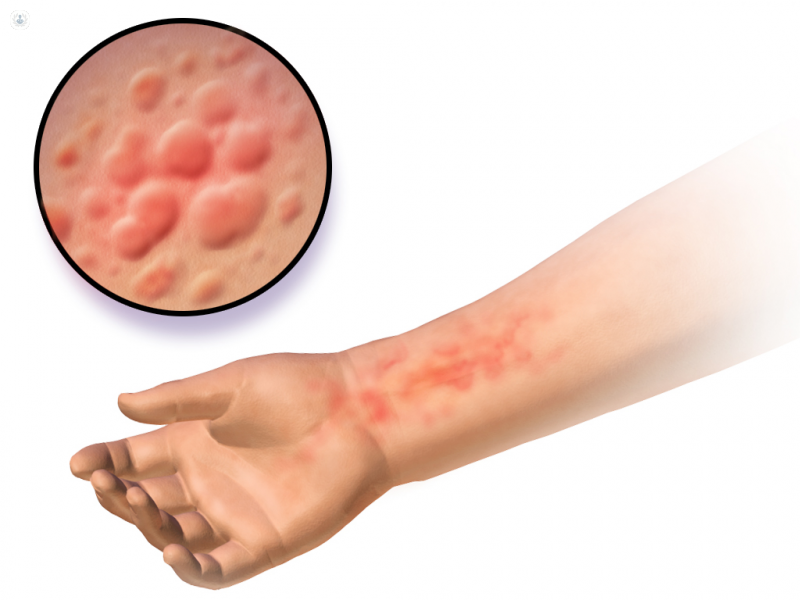

What is toxicoderma?
Toxicoderma is a series of reactions in the skin (dermatosis), mucous membranes and/or appendages caused by drugs.
The most frequent reactions are mucocutaneous disorders (25-30%). Although any drug can cause toxicoderma, most drug reactions are caused by antibiotics, antiseptics, and analgesics/anti-inflammatory drugs.

In childhood, the main reactions are:
- Exanthemas (rashes): these are the most frequent and are subdivided into: scarlet fever (small macules and papules that can develop into generalised plaques), morbilliform (larger macules and papules that tend to merge into plaques) and roseoliform (non-contiguous macules that first appear on the torso and then extend to the palms of the hands and the soles of the feet). These reactions usually subside quickly, although they can sometimes lead to more severe forms.
- Pigmented fixed erythema: this occurs in the form of round, purplish plaques that sometimes appear with blisters. It is associated with anti-inflammatory analgesics, sulphonamides and antibiotics.
- Hives and angioedema: this involves hives that appear spontaneously after 4-6 hours. This can be serious if the reaction persists for more than 24 hours or if there is facial swelling. It is associated with aspirin and beta-lactam antibiotics. Angioedema is a form of hives that affects the subcutaneous tissue. If it affects the face it must be treated quickly as it can obstruct the airway.
- Acneiform rash: this appears as papules and monoform pustules on the forehead, shoulders, and arms. It is often associated with hormone treatment, halogenated substances, vitamins, isoniazid and anticonvulsants.
- Vasculitis: only 10% of cases are caused by drugs. It manifests itself as palpable purpura that usually appear on the lower extremities.
- Serum sickness: this presents as a fever, arthralgia and a morbilliform or rash. It is usually caused by protein derivatives and antibiotics.
- Stevens-Johnson syndrome (SJS)/toxic epidermal necrolysis (TEN): associated with sulphonamides, anti-seizure drugs, NSAIDs, allopurinol, beta-lactam antibiotics and nevirapine. It usually appears between 1 and 3 weeks after taking the drug, in the form of inflamed and purpuric macules. The skin usually comes away when rubbed and vesicles and blisters appear, resulting in epidermal detachment.
- Drug hypersensitivity syndrome: appears progressively between 2 to 6 weeks after initiation of medication (usually anticonvulsants and sulphonamides). It manifests itself with facial swelling and a rash that may evolve into widespread skin peeling.
- Photosensitivity reactions that occur with oral or topical medications after exposure to the sun. These include phototoxicity (in the form of sunburn) and photoallergy (in the form of eczema). In children it is usually associated with naproxen, tetracyclines and their derivatives.
- Erythroderma: presents with scaly erythema associated with oedema, alopecia and alterations of the nails and mucous membranes. It is associated with penicillin, sulphonamides, nitrofurantoin, gold salts and antimalarial drugs.
Prognosis of the disease
Toxicoderma are usually benign and subside between the first and third week upon withdrawal of the drug that triggered them.
Medical tests for toxicoderma
To confirm toxicoderma, a clinical examination will be performed and drug history taken. A skin biopsy may also be taken. An analytical and hypersensitivity study of the suspected drug may also be necessary.
What causes toxicoderma?
Predisposing factors for toxicoderma include being female, having certain underlying diseases, viral infections, sun exposure and the properties of the drug as well as how the drug was taken.
Can it be prevented?
Certain measures can be taken to prevent the onset of toxicoderma, such as:
- avoid taking too much medication
- prescribe known medications, at an appropriate dosage
Treatments for toxicoderma
The main treatment for toxicoderma is to completely withdraw the medication that caused the problem.
Mild forms of toxicoderma usually require symptomatic treatment with oral antihistamines and corticosteroids. However, if it is serious, then hospitalisation, fluid replacement and/or the use of antimicrobials may be necessary.
Which specialist treats it?
The dermatologist is the specialist who treats toxicoderma.
